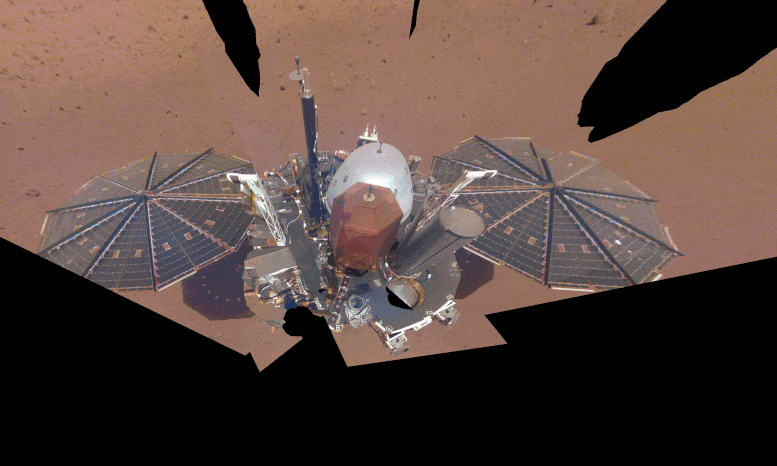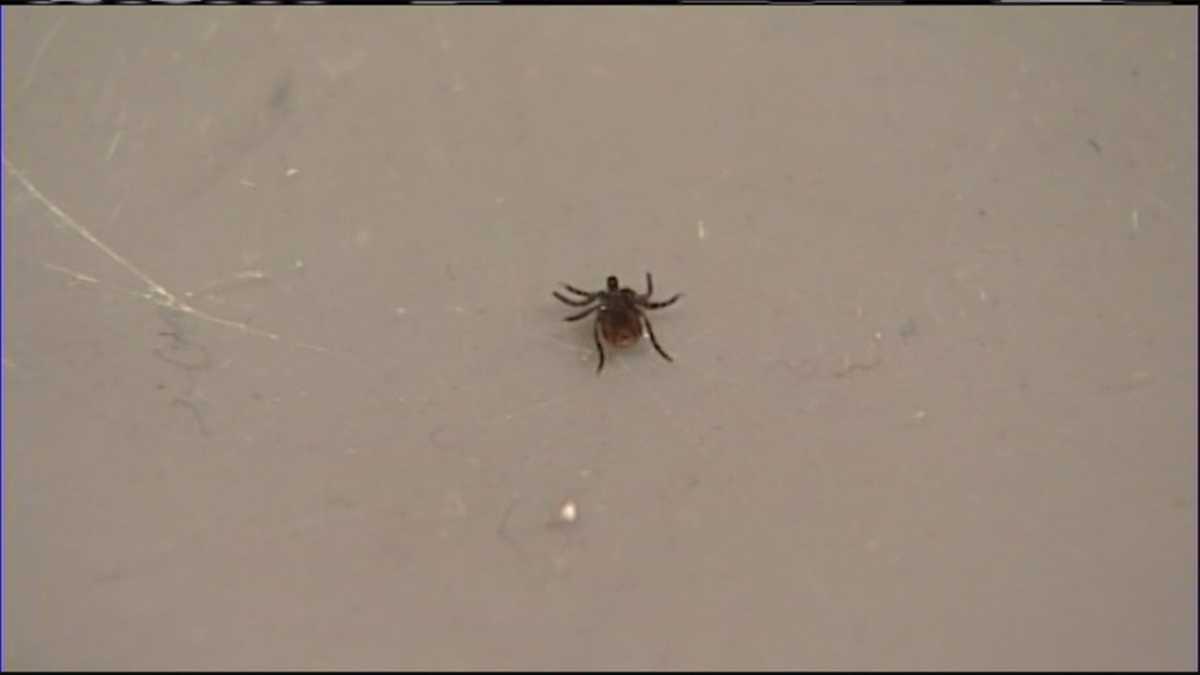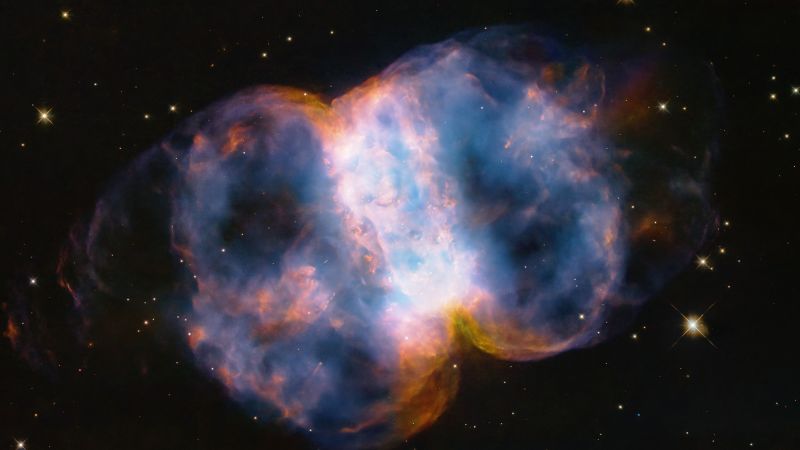Salīdzināšanas nolūkos šis attēls tiek mainīts starp Insight pirmo un pēdējo iemiesojumu. Izmantojot kameru uz tās robotizētās rokas, NASA zonde InSight iemūžināja šos pašbildes 2018. gada 6. decembrī — tikai 10 dienas pēc nolaišanās uz Marsa — un 2022. gada 24. aprīlī. Uz zondes un tās saules paneļiem ir redzams biezs putekļu slānis. pēdējais attēls. Pateicība: NASA/JPL-Caltech
Sīkāk apskatiet, kas ir nepieciešams, lai pabeigtu misiju, jo InSight kosmosa kuģa strāvas padeve turpina samazināties.
tuvu beigām[{” attribute=””>NASA’s Mars InSight lander. The day is fast approaching when the spacecraft will fall silent, ending its history-making mission to reveal secrets of the Red Planet’s interior. Since the spacecraft’s power generation continues to decline as windblown dust on its solar panels thickens, the engineering team has already taken steps to continue as long as possible with what power remains. Despite these efforts, it won’t be long now, as the end is expected to come in the next few weeks.
Although InSight’s tightknit 25-to-30-member operations team – a small group compared to other Mars missions – continues to squeeze the most they can out of InSight, they’ve also begun taking steps to wind down the mission.
Here’s a glimpse of what that looks like.

This is NASA InSight’s first full selfie on Mars. It displays the lander’s solar panels and deck. On top of the deck are its science instruments, weather sensor booms, and UHF antenna. The selfie was taken on December 6, 2018 (Sol 10). Credit: NASA/JPL-Caltech
Preserving Data
With InSight (short for Interior Exploration using Seismic Investigations, Geodesy and Heat Transport), the most important of the final steps of the mission is storing its trove of data and making it accessible to researchers around the world. Already, the data from the lander has yielded details about Mars’ interior layers, its liquid core, the surprisingly variable remnants beneath the surface of its mostly extinct magnetic field, weather on this part of Mars, and lots of quake activity. More insights are sure to follow, as scientists continue to sift through the data.
InSight’s seismometer, provided by France’s Centre National d’Études Spatiales (CNES), has detected more than 1,300 marsquakes since the lander touched down in November 2018. The largest quake it detected measured a magnitude 5. It even recorded quakes from meteoroid impacts. Observing how the seismic waves from those quakes change as they travel through the planet offers an invaluable glimpse into Mars’ interior. Beyond that, these observations also provide a better understanding of how all rocky worlds form, including Earth and its Moon.

NASA’s InSight Mars lander took this final selfie on April 24, 2022, the 1,211th Martian day, or sol, of the mission. The lander is covered with far more dust than it was in its first selfie, taken in December 2018, not long after landing. Credit: NASA/JPL-Caltech
“Finally, we can see Mars as a planet with layers, with different thicknesses, compositions,” said Bruce Banerdt of NASA’s Jet Propulsion Laboratory (JPL) in Southern California, the mission’s principal investigator. “We’re starting to really tease out the details. Now it’s not just this enigma; it’s actually a living, breathing planet.”
The seismometer readings will join the only other set of extraterrestrial seismic data, from the Apollo lunar missions, in NASA’s Planetary Data System. They will also go into an international archive run by the Incorporated Research Institutions for Seismology, which houses “all the terrestrial seismic network data locations,” said JPL’s Sue Smrekar, InSight’s deputy principal investigator. “Now, we also have one on Mars.”
Smrekar said the data is expected to continue yielding discoveries for decades.

The rocket that launched NASA’s InSight lander to Mars in 2018 is seen at Vandenberg Air Force Base, now called Vandenberg Space Force Base. Credit: NASA/JPL-Caltech/Charles Babir
Managing Power
Earlier this summer, the lander had so little power remaining that the mission turned off all of InSight’s other science instruments in order to keep the seismometer running. They even turned off the fault protection system that would otherwise automatically shut down the seismometer if the system detects that the lander’s power generation is dangerously low.
“We were down to less than 20% of the original generating capacity,” said Banerdt. “That means we can’t afford to run the instruments around the clock.”
Recently, after a regional dust storm added to the lander’s dust-covered solar panels, the team decided to turn off the seismometer altogether in order to save power. Now that the storm is over, the seismometer is collecting data again. However, the mission expects the lander only has enough power for a few more weeks.
Of the seismometer’s array of sensors, only the most sensitive were still operating, said Liz Barrett, who leads science and instrument operations for the team at JPL, adding, “We’re pushing it to the very end.”
dvīņu iepakojumi
Klusais komandas loceklis ir ForeSight, InSight pilna izmēra inženierijas modelis JPL. Instrumentu laboratorija uz vietas. Inženieri izmantoja ForeSight, lai praktizētu, kā InSight varētu novietot zinātniskus instrumentus uz Marsa virsmas, izmantojot rovera robotu roku, Pārbaudes metodes Lai ievadītu zondes temperatūras zondi Lipīga Marsa augsneattīstot metodes Trokšņa samazināšana Ņemts ar seismometru.
Forsight tiks ievietots uzglabāšanas kastē. “Mēs to piepildīsim ar mīlošu aprūpi,” sacīja Banerds. “Viņa bija lielisks instruments, lielisks pavadonis mums visā šajā misijā.”

Reaktīvo dzinēju laboratorijas izmēģinājuma telpā inženieri apmāca izmantot InSight instrumentus, izmantojot ForeSight — pilna izmēra nolaišanās ierīces kopiju, kas tiks mobilizēta, kad misija būs pabeigta. Daudzi inženieri valkā saulesbrilles, lai bloķētu spilgti dzeltenos gaismas, kas atdarina saules gaismu, kad tās parādās uz Marsa. Pateicība: NASA/JPL-Caltech/IPGP
Paziņojums par misijas beigām
Ja InSight izlaiž divas secīgas kontakta sesijas ar ap Marsu riņķojošo kosmosa kuģi, daļa no Marsa releju tīklsNASA paziņos par misijas beigām. Tomēr šis noteikums ir spēkā tikai tad, ja savienojuma zuduma cēlonis ir pati zonde, sacīja tīkla administrators Rojs Gledens no JPL. Tad NASA dziļā kosmosa tīkls Viņš kādu laiku turpinās klausīties, katram gadījumam.
Tomēr nebūs nekādu varonīgu darbību, lai atjaunotu savienojumu ar InSight. Lai gan misijas glābšanas notikums, piemēram, stiprs vējš, kas pūš paneļus, nav neiespējams, tas tiek uzskatīts par pilnīgi neticamu.
Tikmēr, kamēr InSight sazināsies, komanda turpinās vākt datus. “Mēs turpināsim veikt zinātniskos mērījumus, cik ilgi vien iespējams,” sacīja Banerdts. “Mēs esam Marsa žēlastībā. Laikapstākļi uz Marsa nav lietus un sniegs; laikapstākļi uz Marsa ir putekļi un vējš.”
Vairāk par misiju
NASA reaktīvo dzinēju laboratorija (JPL) pārvalda NASA Zinātnes misijas direktorāta programmu InSight. InSight ir daļa no NASA Discovery programmas, ko pārvalda aģentūras Māršala kosmosa lidojumu centrs Hantsvilā, Alabamā. Lockheed Martin Space no Denveras ir uzbūvējis InSight kosmosa kuģi, tostarp kruīza posmu un nolaišanās ierīci, un atbalsta misijas kosmosa kuģu darbības.
Vairāki Eiropas partneri, tostarp Francijas Nacionālais kosmosa pētījumu centrs (CNES) un Vācijas Aviācijas un kosmosa centrs (DLR), atbalsta InSight misiju. Nacionālais kosmosa pētījumu centrs ir nodrošinājis NASA iekšējās struktūras seismisko eksperimentu (SEIS) instrumentu kopā ar IPGP (Institut de Physiques d’Institut d’Institut d’Institut d’Institut du Physique) galveno pētnieku. Pasaule Parīzē). Ievērojamu ieguldījumu kopējā vides informācijas sistēmā sniedza IPGP; Maksa Planka Saules sistēmas izpētes institūts (MPS) Vācijā; Šveices Federālais tehnoloģiju institūts (ETH Zurich) Šveicē;[{” attribute=””>Imperial College London and Oxford University in the United Kingdom; and JPL. DLR provided the Heat Flow and Physical Properties Package (HP3) instrument, with significant contributions from the Space Research Center (CBK) of the Polish Academy of Sciences and Astronika in Poland. Spain’s Centro de Astrobiología (CAB) supplied the temperature and wind sensors, and the Italian Space Agency (ASI) supplied a passive laser retroreflector.





